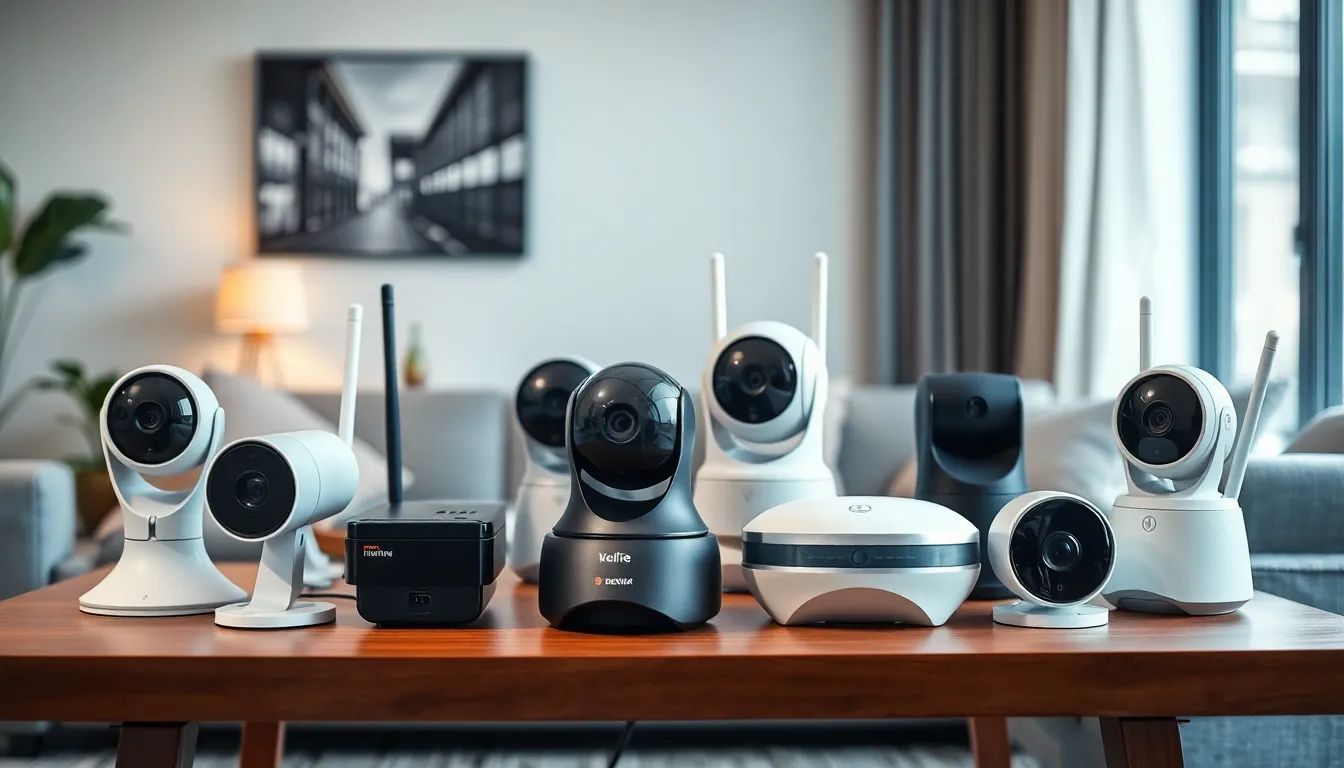In a world where the neighbor’s cat seems to be plotting world domination, home security cameras have become the unsung heroes of modern living. These little gadgets not only keep an eye on the house but also serve as the ultimate peace-of-mind insurance policy. Who wouldn’t want to know if that suspicious figure lurking around their porch is just a delivery driver or a rogue squirrel with a vendetta?
With technology evolving faster than a toddler can throw a tantrum, today’s cameras offer features that would make James Bond jealous. From motion detection to night vision, they’re ready to capture every moment—like that time your dog decided the couch was his personal chew toy. Investing in home security cameras isn’t just about protection; it’s about securing your sanity and maybe even getting a few laughs along the way.
Table of Contents
ToggleOverview of Home Security Cameras
Home security cameras serve as vital tools for safeguarding residences. These devices have evolved significantly, featuring advanced technology that enhances their effectiveness. Motion detection systems automatically alert users to unexpected movement, enhancing real-time monitoring. Night vision capabilities allow for clear footage in low-light settings, providing comprehensive surveillance around the clock.
Many homeowners appreciate the convenience of smartphone integration. Users can monitor live feeds and receive instant notifications from anywhere, empowering them to respond swiftly to potential threats. Wireless options simplify installation, making it easier to place cameras in strategic locations without extensive wiring.
Cloud storage solutions have gained traction due to their ease of access and reliability. By storing video footage offsite, homeowners ensure their recordings remain secure, even if the camera or local storage is compromised. Some systems utilize artificial intelligence to distinguish between people and pets, reducing false alarms and improving surveillance accuracy.
Considering aesthetics, sleek designs of modern cameras blend well with home decor. Options range from unobtrusive indoor models to outdoor designs built to withstand harsh weather. Flexibility in camera types allows users to choose devices that best suit their security needs, whether they prefer dome cameras for wider views or bullet cameras for focused monitoring.
Ultimately, the choice of home security cameras depends on specific requirements and preferences. Evaluating features, installation ease, and monitoring capabilities assists in selecting the most suitable system for any household.
Types of Home Security Cameras

Home security cameras come in various types, catering to different security needs. Understanding these types helps in choosing the right fit for any residence.
Wired Vs. Wireless Cameras
Wired cameras connect directly to a power source and record footage to a digital video recorder (DVR). These systems often provide reliable connections and consistent video quality. Wireless cameras use Wi-Fi to transmit data, making installation simpler and less invasive. Wireless options are often more flexible regarding placement, especially in areas without easy access to power outlets. Interference may occasionally affect wireless signals, while wired systems avoid this issue.
Indoor Vs. Outdoor Cameras
Indoor cameras focus on monitoring the interior of a home. These devices often feature lenses that provide a wider field of view, capturing more area for security. Outdoor cameras withstand harsh weather conditions and include features like weatherproof casing and night vision capabilities. Outdoors, cameras may use additional motion detection to minimize false alarms from animals or moving foliage. Indoor systems are typically smaller and less obtrusive than their outdoor counterparts.
Key Features to Consider
Home security cameras come equipped with various features that enhance their utility and effectiveness. Understanding these features helps homeowners make informed decisions.
Video Quality and Resolution
Video quality is crucial for identifying people and objects clearly. Most modern cameras offer HD resolution, with options ranging from 720p to 4K. A camera with higher resolution provides better detail, making it easier to capture faces or license plates. Users should consider cameras that provide high-definition video during both day and night conditions. Additionally, some models offer digital zoom capabilities, allowing users to enlarge specific areas in recorded footage.
Night Vision and Motion Detection
Night vision capabilities enable clear monitoring after dark. Infrared technology comes standard with many cameras, improving visibility in low-light conditions. Motion detection enhances security by sending alerts when movement is detected within specified zones. Adjustable sensitivity settings allow users to minimize false alarms caused by pets or passing vehicles. Cameras that integrate both night vision and motion detection significantly improve safety and peace of mind.
Storage Options
Storage solutions play a vital role in retaining video footage. Options typically include local storage, such as microSD cards, and cloud storage services. Local storage provides immediate access to recorded footage, but the capacity may be limited. Cloud storage offers the advantage of remote access and redundant backups, ensuring that video remains secure. Homeowners should evaluate their storage needs, considering factors like retention duration and accessibility.
Benefits of Using Home Security Cameras
Home security cameras offer numerous advantages that enhance overall safety. Increased surveillance capability helps deter criminal activity, giving homeowners peace of mind. Enhanced monitoring allows for real-time viewing, making it easy to check on pets or children while away.
Ease of access to alerts keeps homeowners informed, as notifications arrive instantly when motion is detected. Many models integrate with smartphones, ensuring users can view live feeds from anywhere, enhancing convenience. Surveillance footage provides valuable evidence, assisting law enforcement if a crime occurs.
Advanced features such as night vision and motion detection significantly improve functionality. Night vision technology ensures effective monitoring during low-light conditions, expanding the scope of coverage. Motion detection capabilities minimize false alarms, triggering alerts only when necessary.
Cost-effectiveness can result from reduced insurance premiums. Many insurance providers lower rates for homes equipped with security cameras. This reduction offers not just savings but also promotes investment in enhanced safety.
Diversity in camera options means users can select models tailored to their specific needs. Indoor cameras focus on monitoring family activities while outdoor cameras withstand diverse weather conditions. Aesthetically pleasing designs also allow integration into home decor without compromising style.
Cloud storage provides an extra layer of security for video footage. Footage remains accessible even after the camera gets damaged or stolen, ensuring continuous protection. Home security cameras represent a comprehensive solution, prioritizing safety and convenience for every household.
Popular Home Security Camera Brands
Numerous brands dominate the home security camera market, each offering unique features and technologies. Nest provides integration with Google Assistant and a user-friendly interface, appealing to smart home enthusiasts. Arlo stands out with its wireless options and high-definition video quality, ideal for both indoor and outdoor surveillance.
Ring specializes in video doorbells alongside security cameras, focusing on community monitoring and two-way audio capabilities. Wyze presents budget-friendly options without sacrificing performance, making it a popular choice for value-oriented consumers.
Blink delivers simplicity with wireless cameras that operate on long-lasting batteries, ensuring ease of installation and minimal maintenance. Lorex manufactures a wide range of systems, including advanced DVRs, catering to those needing comprehensive security solutions.
Amcrest combines competitive pricing with robust features, such as pan-tilt-zoom functionality and expandable storage options, appealing to tech-savvy users. Eufy’s emphasis on local storage options, void of subscription fees, resonates with those concerned about privacy.
Reolink showcases products that emphasize solar-powered solutions, catering to environmentally conscious consumers and those seeking flexibility in camera placement. Each of these brands contributes to a diverse selection of home security cameras that cater to various needs, preferences, and budgets.
Home security cameras have become essential tools for safeguarding residences and enhancing peace of mind. With advanced features like night vision and motion detection, they not only protect but also add a touch of convenience to daily life. The variety of options available ensures that homeowners can find the perfect fit for their specific needs and preferences.
Investing in a quality security camera system can lead to increased safety and even lower insurance costs. As technology continues to evolve, these devices are set to become even more effective and user-friendly. Choosing the right camera means prioritizing both security and the overall aesthetic of the home, making it a worthwhile investment for anyone looking to enhance their living environment.


